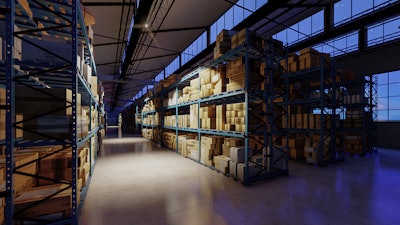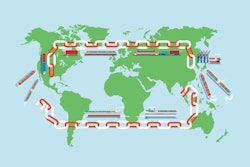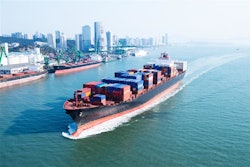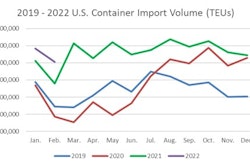
Imagine you’re laying on a cruise ship deck, the sun is shining, your “out of office” replies are on and you’re about to hit up the second round of that all-you-can-eat buffet. You’re probably not thinking about the fact that the dairy products in your breakfast are unpasteurized, or the cocktail you’re enjoying is duty-free.
From nearshoring to offshoring to just-in-time (JIT) fulfillment, the food logistics world is complex and constantly working behind the scenes, so consumers don’t have to think about those details. Cruise ships are an anomaly—floating in international waters where they can source tastier food at a lower cost without worrying about duties or compliance delays.
As the food logistics world faces new challenges every day, today’s food manufacturers and distributors could learn a thing or two from those who operate in international waters. Let’s walk down the path of least resistance -- global trade management.
Nearshoring vs. offshoring vs. just-in-time fulfillment: Time to reassess?
First, it’s important to understand the different tactics global supply chains use to save costs, distribute faster and manage international regulations. Offshoring is the practice of developing supplier and logistics partnerships in developing countries because it has made fiscal sense to offshore operations. However, as fuel and shipping container costs continue to rise—skyrocketing further since the beginning of the pandemic—many chief supply chain officers (CSCO) are reassessing their strategy, both from a cost and reliability perspective.
One alternative to offshoring is nearshoring, locating operations in a bordering country to save costs, while still being close enough to the customer base to make fiscal sense. However, cross-border distribution can be complicated, requiring specific customs documentation or costly duties to get the product from facility to customer on time.
Both near and offshoring have played a part in the proliferation of the JIT fulfillment model. JIT was originally used to achieve high-volume production and eliminate waste, with the goal to minimize inventory on hand to meet demand “just in time.” In a post-pandemic world, that strategy needs to be rethought. Take an appliance manufacturer for example who makes refrigerators for global distribution. During the pandemic, their manufacturing facility ran out of a certain sized bolt, causing the entire production line to be shut down for months.
In the face of the pandemic where food manufacturers and logistics providers have been unable to meet demand or supply basic materials because the inventory was stuck overseas in an offshore facility or a specific ingredient was out of stock because it was stuck on a shipping container off the coast of California, it’s simply not a viable choice for businesses today amid unprecedented disruption. When the inventory is so lean that a single part can shut down production for months, it’s time to rethink your strategy.
But, many manufacturers and distributors will ask, if I no longer follow JIT, how can I afford to pay 25% duties and carrying costs on inventory that I may or may not use?
The real question should be, how can I best serve my customer, at the lowest possible overhead, while still preparing for supply chain disruption?
That’s where solutions like foreign-trade zones (FTZs) and global trade management come in.
Set sail on a new global trade strategy
It’s important to note that one of the many reasons companies have chosen to nearshore is to avoid costly U.S. tariffs and taxes. However, FTZs offer a solution to that. In fact, using an FTZ is a lot like cruising in international waters.
FTZs, also referred as “free-trade zones,” are designated areas in the United States where goods may be received, packaged, manufactured, processed and re-exported without the intervention of the customs authorities. In essence, FTZs allow domestic activity involving foreign items to take place prior to formal customs entry. As a result, manufacturers and distributors can leverage these zones to drastically reduce or eliminate duty costs and improve supply chain productivity. Savings on weekly entry fees, duty exemption and inverted tariff relief, to name a few, can add up to millions of dollars in cost savings and offer a strong competitive advantage for U.S. manufacturers and distributors.
Take liquor distribution as an example. If a beverage distributor does not use a FTZ or deferral bonded facility, they have to pay both federal and state taxes, which can add up quickly. With FTZs, the alcohol is brought into the zone, then distributed to the individual states, but they only pay that tax once.
As a manufacturer or food logistics organization navigates a change in their supply chain strategy, it’s important to undergo a cost/benefit analysis to identify key areas that may benefit from an FTZ. Some may ask, FTZs are a great way to eliminate heightened costs, but what about other areas of my business affected by supply chain shortages and disruptions?
When navigating a supply chain strategy shift, it’s critical to understand all affected elements of your business, such as:
● Duty implications of changing your source/country of origin.
● Applicable free trade agreements.
● Differing cross-border regulations or jurisdictions.
When a company distributes a product, especially in the food and beverage industry, the process is complex, with different rules for each country of origin. While FTZs are an unbeatable cost-saver, it can put a wrinkle in the overall global trade process.
Grab your passport: Global trade management
In the food and beverage industry, regulations and requirements differ depending on the destination and/or country of origin. For example, what’s considered “gluten-free” in the United States is different than in Australia. Or virgin olive oil in the states is classified differently than what it is in Europe. This is primarily due to differing organizations – U.S. Food and Drug Administration, Australian Department of Agriculture and Water Resources, the European Food Safety Authority, to name a few, that regulate the food and beverages that enter and exit their jurisdiction.
As a food logistics organization, ensuring compliance with these entities is critical to promoting a safe, efficient and cost-effective supply chain for a company and its customers. Global trade management (GTM) software can help reduce friction for distribution channels across international borders. Much like a cruise ship that can import from Europe, the United States or China without regulatory disruptions, why shouldn’t your business?
GTM can automate cross border distribution, seamlessly identifying the documentation, customs reporting, procedures and certificates needed to get the products from a facility to the customer quickly and in the most cost-effective way. This is often done through import/export management, restricted party screening and FTZs. GTM can also standardize shipping processes across organizations, track and manage deliveries, verify freight costs and switch between carriers if needed. This not only improves the bottom line, but also builds customer loyalty and takes advantage of every tool available to ensure on-time and cost-effective delivery for the supply chain and its customer.
It's time to rethink your supply chain strategy. In a new post-pandemic world, nearshoring, offshoring and JIT may no longer fit your business needs—or your customers’. Take the time to evaluate your processes so your supply chain is ready for today’s challenges and beyond. Much like the all-you-can-eat buffet on the next cruise, one thing is guaranteed -- with global trade management, it’s smooth sailing from here on out.




















